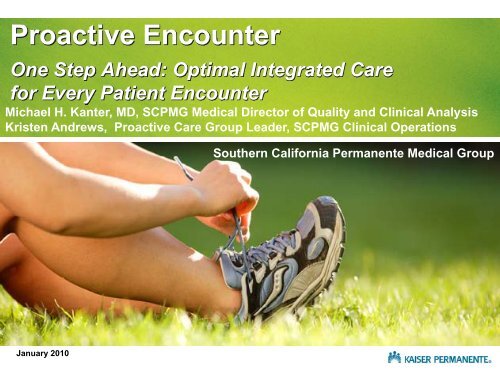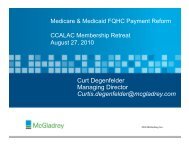Proactive Encounter One Step Ahead
Proactive Encounter One Step Ahead
Proactive Encounter One Step Ahead
You also want an ePaper? Increase the reach of your titles
YUMPU automatically turns print PDFs into web optimized ePapers that Google loves.
<strong>Proactive</strong> <strong>Encounter</strong><br />
<strong>One</strong> <strong>Step</strong> <strong>Ahead</strong>: Optimal Integrated Care<br />
for Every Patient <strong>Encounter</strong><br />
Michael H. Kanter, MD, SCPMG Medical Director of Quality and Clinical Analysis<br />
Kristen Andrews, <strong>Proactive</strong> Care Group Leader, SCPMG Clinical Operations<br />
Southern California Permanente Medical Group<br />
January 2010
Goal<br />
<strong>Proactive</strong> Office <strong>Encounter</strong>:<br />
The project aims to improve the consistency and<br />
quality of preventive and chronic care by;<br />
• Activating ALL members of the healthcare team in<br />
providing a proactive patient care experience,<br />
• Embedding processes to support preventive and<br />
chronic care needs into standard workflows, and<br />
• Utilizing information technology tools for<br />
identification of patient care gaps.<br />
2<br />
Confidential & Proprietary
Target Population<br />
• All members in KPSC<br />
• Every outpatient encounter, including<br />
specialty clinics – Approximately 12<br />
million visits annually<br />
• Future plan: <strong>Proactive</strong> Inpatient<br />
<strong>Encounter</strong> and Call Center POE<br />
(Every patient, Every visit, Every time)<br />
3<br />
Confidential & Proprietary
Session Objectives<br />
Identify opportunities to create a highly reliable care process<br />
that will lead to:<br />
• Improved quality and patient care experience<br />
• Fewer missed opportunities to improve preventive care and chronic<br />
disease management<br />
• Increased efficiency<br />
• Optimal Clinician support in specialty care as well as primary care<br />
• Strategies to have specialty care departments provide primary<br />
prevention and cancer screening.<br />
Apply similar workflows/tools that will result in an increased<br />
partnership leading to:<br />
• Consistent support to physician practice,<br />
• Panel ownership and performance<br />
• Empowered and engaged staff<br />
• Better partnership between physician and health care team<br />
4<br />
Confidential & Proprietary
Presentation Agenda<br />
• Development of <strong>Proactive</strong> Office <strong>Encounter</strong> (POE)<br />
Strategy<br />
• Tools that support the workflow<br />
• POE Data<br />
• Future POE work<br />
5<br />
Confidential & Proprietary
Let’s make it personal.<br />
6<br />
Confidential & Proprietary
<strong>Proactive</strong> <strong>Encounter</strong> Patient Story<br />
• Dale Gordon, Kaiser Permanente member<br />
7<br />
Confidential & Proprietary
Making the Business Case<br />
Opportunities for Breast Cancer and Diabetes Management<br />
in Adult Primary Care<br />
Test<br />
Total<br />
Seen in<br />
Primary Care<br />
%<br />
Needing<br />
Mammogram<br />
Needing A1c<br />
test<br />
47,294 18,222 38%<br />
10,530 3,911 37%<br />
• Difficult to reach success if we only focus on Primary Care<br />
• Approximately 60% of our members are seen in Specialty Care where<br />
we have an opportunity to close these and other Care Gaps<br />
8<br />
Confidential & Proprietary
Clinical Outcome<br />
- Hospitalizations reduced; deaths avoided<br />
METRIC<br />
%<br />
Increase<br />
Lives Saved Per Decade<br />
Cholesterol Control 17.5% 1406 Lives<br />
Blood Pressure Control 36.2% 4972 Lives<br />
HbA1C < 9.0 8.7% 823 Lives<br />
Smoking Cessation 14.0% 787 Lives<br />
Breast Cancer Screening 11.6%<br />
580 Lives<br />
Cervical Cancer Screening 6.0% 39 lives<br />
Colon Cancer Screening 25.7% 4075 lives<br />
TOTAL<br />
12,684 Lives Saved<br />
9<br />
Confidential & Proprietary
<strong>Proactive</strong> <strong>Encounter</strong> embodies our<br />
integration strategy.<br />
10<br />
Integration is our strength and what sets us<br />
apart from the competition.<br />
Confidential & Proprietary
Partnership to Performance:<br />
Expected Outcomes<br />
11<br />
• Highly reliable care<br />
process<br />
– Improved quality<br />
– Fewer missed<br />
opportunities<br />
– Increased efficiency<br />
– Technology supports<br />
workflow<br />
– Industry-leading<br />
performance<br />
– Optimal MD support<br />
Confidential & Proprietary<br />
• Partnership<br />
– Physician and health<br />
care team<br />
– Consistent support<br />
to physician practice<br />
– Panel ownership and<br />
performance<br />
– Staffing supports<br />
model<br />
– Empowered and<br />
engaged staff
<strong>Proactive</strong> <strong>Encounter</strong> Experience<br />
Pre <strong>Encounter</strong><br />
<strong>Proactive</strong><br />
Identification<br />
• Identify missing<br />
labs, screening<br />
procedures, access<br />
management, kp.org<br />
status, etc.<br />
• Provide member<br />
instructions prior to<br />
visit<br />
• Contact member and<br />
document encounter<br />
in KP<br />
HealthConnect<br />
Office <strong>Encounter</strong><br />
Office <strong>Encounter</strong> Management<br />
• Vital sign collection /<br />
documentation<br />
• Identify and flag alerts for provider<br />
• Room and prepare patient for<br />
necessary exams<br />
• Pre-encounter follow-up<br />
<strong>Proactive</strong> Office Support<br />
• Phone calls<br />
• Letters<br />
• E-mail<br />
• Inbox Management<br />
Post <strong>Encounter</strong><br />
Immediate<br />
• After visit summary,<br />
after care<br />
instructions, followup<br />
appointments,<br />
Health Ed materials,<br />
how to access info<br />
on kp.org<br />
Future<br />
• Follow-up contact<br />
and appointments<br />
per provider<br />
12<br />
Confidential & Proprietary
Intervention Design<br />
- Key elements<br />
• Processes for staff to fill care gaps for all patients<br />
• Screenings<br />
– Pap, Mammogram, FOBT, DEXA<br />
• Lab Reminders<br />
– A1c, Microalbumin, LDL, Chlamydia<br />
• Immunizations<br />
– Flu, Pneumovax, Pediatric Immunizations<br />
• Chronic Conditions (DM, HTN, Persistent Asthma)<br />
– Retinal exam, shoes off for foot exam, glucose meters, health ed classes<br />
– Blood pressure measurements<br />
– Asthma questions to determine if patient is “in control”<br />
• Body Mass Index<br />
– Height and weight<br />
• Smoking inquiry<br />
13<br />
Confidential & Proprietary
Overview of<br />
<strong>Proactive</strong> <strong>Encounter</strong> Tools
Building Blocks of <strong>Proactive</strong> Care<br />
Performance<br />
Improvement<br />
Measuring Performance<br />
Train/Validate Skills of All Staff<br />
Physician Preference Sheet<br />
Specialty Specific Work Flows<br />
Standard Medical Office Work Flows<br />
15<br />
Confidential & Proprietary
<strong>Proactive</strong> <strong>Encounter</strong> Work Flows<br />
Standard Work Flows<br />
• Improve Quality<br />
• Improve Efficiency<br />
• Improve Physician support<br />
• For medical office visit<br />
• Supplemented by Specialty Specific Work Flows<br />
Work Flow Tools<br />
16<br />
• Standard POE Work Flows<br />
• Team Agreements<br />
• Video Tutorials<br />
• Job Aids<br />
• <strong>Proactive</strong> Care Booklet<br />
Confidential & Proprietary
Standard<br />
Work Flow<br />
17<br />
Confidential & Proprietary
<strong>Proactive</strong> Office <strong>Encounter</strong><br />
Team Agreement<br />
For Provider – MA/LVN/RN<br />
“Our Cause is Health. Our Passion is Service. We’re Here to Make Lives Better”<br />
Provider: Medical Assistant/LVN/RN: Meeting Date: _______________________<br />
We share responsibility for providing an outstanding care experience for our members, outstanding clinical care, outstanding performance in panel<br />
management/clinical goals, outstanding performance as a partner team/team member, and an outstanding working experience for our team.<br />
Ground Rules for Team Agreement Meeting<br />
This team agreement serves to enhance communication between the provider and medical assistant, LVN, or RN. During this meeting, we<br />
ask that team members treat each other with respect and remain open to new ideas. Use positive verbal and nonverbal feedback by asking<br />
rather than demanding. This is an opportunity for each team member to express their needs clearly. It should be based on a collaborative<br />
approach versus a “top-down” approach.<br />
Instructions:<br />
1. Meet together and determine what is important to your practice.<br />
2. Review “sample” team agreement and use as a guideline for your meeting.<br />
3. Below are statements that allow you to discuss your role(s) as it relates to POE. Discuss your roles using the sample document to assist you.<br />
4. Review and revise at agreed intervals. This living document serves to clarify the goals, roles, and procedures, as necessary, for effective teamwork.<br />
1. How do we start the day?<br />
2. Practice Guidelines and Documentation (Chief Complaint, Vital Signs, Medical and Social History, Demographics, Allergies, and Medications)<br />
Provider<br />
MA/LVN/RN<br />
18<br />
Confidential & Proprietary
<strong>Proactive</strong> <strong>Encounter</strong> Tools<br />
Administrative Tools<br />
‣Suggested Team with Roles and<br />
Responsibilities<br />
‣<strong>Proactive</strong> Care Readiness Check List<br />
‣Chart Review Tool<br />
‣Workflow Efficiency Audit Tool<br />
‣Physician Survey<br />
19<br />
Confidential & Proprietary
Readiness<br />
Checklist<br />
20<br />
Confidential & Proprietary
Physician<br />
Survey<br />
21<br />
Confidential & Proprietary
<strong>Proactive</strong> <strong>Encounter</strong> Tools<br />
Training Tools<br />
‣POE Skills Inventory<br />
‣Skills Validation Tool<br />
‣<strong>Proactive</strong> Care CD & Web Site<br />
• Videos<br />
• Job Aids<br />
• All Administrative & Work Flow Tools<br />
22<br />
Confidential & Proprietary
POE Skills<br />
Inventory<br />
23<br />
Confidential & Proprietary
Skills<br />
Validation<br />
Tool<br />
24<br />
Confidential & Proprietary
<strong>Proactive</strong> Care Tab<br />
Access to POE Checklists<br />
within HealthConnect<br />
screenshots
<strong>Proactive</strong> Care Activity Tab – Link to POE Checklists<br />
26<br />
Confidential & Proprietary
POE <strong>Encounter</strong> Checklist Display<br />
27<br />
Confidential & Proprietary
<strong>Proactive</strong> Pre-<strong>Encounter</strong>/<strong>Encounter</strong> Checklists<br />
Checklists will be<br />
generated for all<br />
patients identified<br />
as having gaps in<br />
care.<br />
28<br />
Confidential & Proprietary
<strong>Proactive</strong> <strong>Encounter</strong> Pediatrics Checklist<br />
29<br />
Confidential & Proprietary
<strong>Proactive</strong> <strong>Encounter</strong> Patient Story<br />
• Dr. Morrells, Kaiser Permanente Physician<br />
and Member<br />
30<br />
Confidential & Proprietary
<strong>Proactive</strong> <strong>Encounter</strong><br />
SmartTools
Adult <strong>Proactive</strong> <strong>Encounter</strong> SmartSet<br />
32<br />
Confidential & Proprietary
Adult <strong>Proactive</strong> <strong>Encounter</strong> Documentation<br />
SmartPhrase<br />
33<br />
Confidential & Proprietary
<strong>Proactive</strong> Office <strong>Encounter</strong><br />
Data
<strong>Proactive</strong> <strong>Encounter</strong> Tool Percent Utilization<br />
September 2008<br />
Target 75% utilization of POE Tools<br />
35<br />
Confidential & Proprietary
SCAL Regional Trend:<br />
POE Composite Successful Opportunities<br />
100<br />
90<br />
80<br />
70<br />
60<br />
50<br />
40<br />
30<br />
20<br />
10<br />
0<br />
Regional Successful Opportunities Report<br />
July 08 - August 09<br />
Percent Successful<br />
% A1c<br />
% Microalbumin<br />
% LDL<br />
% Mammo<br />
% Pap<br />
% Dexa<br />
% Pneumovax<br />
% Retinal screening<br />
% BMI<br />
% Flu<br />
% Smoking<br />
% Chlamydia<br />
% DM Health Ed<br />
% Asthma Quesr<br />
36<br />
Confidential & Proprietary
<strong>Proactive</strong> <strong>Encounter</strong> in Urgent Care<br />
Bellflower Service Area Pilot Project<br />
November Successful<br />
Opportunity Rates<br />
•Pap Smear – 35%<br />
160<br />
140<br />
Pap Smears in Urgent Care<br />
July - November 2008<br />
150<br />
•Mammogram – 40%<br />
120<br />
120<br />
114<br />
•A1c – 32%<br />
•MAU – 15%<br />
Total Pap Smears<br />
100<br />
80<br />
60<br />
90<br />
94<br />
•LDL – 25%<br />
40<br />
•Chlamydia – 33%<br />
37<br />
20<br />
0<br />
Jul-08 Aug-08 Sep-08 Oct-08 Nov-08<br />
Week<br />
Confidential & Proprietary
<strong>Proactive</strong> <strong>Encounter</strong> in Surgical Urgent Care<br />
Bellflower Service Area Pilot Project<br />
(October – November 08)<br />
38<br />
Confidential & Proprietary
Implementation Roadmap<br />
39<br />
Confidential & Proprietary
Implementation <strong>Step</strong>s<br />
• Develop the leadership team<br />
• Assess readiness<br />
• Share the vision and workflows<br />
• Create department/condition specific work flows<br />
• Develop the training team<br />
• Train and validate skills<br />
• Measure performance<br />
• Performance improvement<br />
40<br />
Confidential & Proprietary
Future: More <strong>Proactive</strong> <strong>Encounter</strong> work to<br />
continue through-out the year<br />
• In progress pilot of POE in Inpatient setting: <strong>Proactive</strong><br />
Inpatient <strong>Encounter</strong><br />
• In progress – Pilot analysis of Pre-<strong>Encounter</strong><br />
automatic calls to members due for labs<br />
• Additional care gap alerts to be included in POE<br />
• POE in Emergency Department capturing labs<br />
• Automated <strong>Proactive</strong> Care Workflow Assessment<br />
• Automated Outreach for Overdue Labs<br />
• Development of POE in Pharmacy<br />
41<br />
Confidential & Proprietary
<strong>Proactive</strong> Inpatient <strong>Encounter</strong> (PIE)<br />
Pre-Admission<br />
(ED/Pre-op)<br />
• Identify needed<br />
labs, screening,<br />
medication<br />
management, etc.<br />
• Provide member<br />
instructions<br />
Admission<br />
• Assessment,<br />
vitals, advance<br />
care directive<br />
documentation<br />
• Prepare patient<br />
for procedure,<br />
tests<br />
• Activate patient<br />
in care: education,<br />
nutritional consult,<br />
social service,<br />
discharge<br />
planning<br />
• Arrange DME,<br />
Home Health,<br />
Post Discharge<br />
Care<br />
Discharge<br />
• Identify and<br />
provide<br />
immunizations<br />
• Med reconciliation<br />
• Discharge care<br />
instructions, followup<br />
appointments,<br />
health ed materials<br />
• Screening<br />
reminders and<br />
appointments<br />
• KP.org registration<br />
• Post Discharge<br />
Call<br />
42<br />
Confidential & Proprietary
Complete Care Experience<br />
43<br />
Confidential & Proprietary
Success Factors<br />
- What practices and tools contributed to success?<br />
• Making it Personal<br />
• Regional pay for performance<br />
• Support the work: believe in it, implement it, reinforce it<br />
• Partner with your local POE Implementation Lead<br />
• Become familiar with elements of the POE model and workflow in<br />
Primary and Specialty Care<br />
• How to Document in HealthConnect TM (Chief Complaint, Vital<br />
Signs, Medical and Social History, Demographics, Allergies, and<br />
Medications)<br />
• How to use the POE Tool in POINT and POE Smartsets and Best<br />
Practice Alerts in HealthConnect TM<br />
• Understand how POE supports the physicians’ practice<br />
44<br />
Confidential & Proprietary
Success Factors<br />
- What practices and tools contributed to success?<br />
• Create a Standard Workflow Agreement<br />
45<br />
Confidential & Proprietary
Success Factors<br />
- What practices and tools contributed to success?<br />
• Physician direct involvement is critical to success of POE<br />
• Engage physicians or the MA will not see value and will not do it<br />
• Regional and local leadership support<br />
• Develop team agreements between your physicians and your nursing<br />
staff; this is a vital piece of the process<br />
• Implementation of Standard & Specialty Specific Workflows<br />
• Exam room readiness<br />
• Patient properly prepared for the examination<br />
• HealthConnect tasks pre-staged as appropriate<br />
• Better partnership between physician and healthcare team<br />
• Reward and recognize performance – “Nice Job”<br />
46<br />
Confidential & Proprietary
<strong>Proactive</strong> <strong>Encounter</strong> Patient Story<br />
• Mary Gonzales, Kaiser Permanente member<br />
47<br />
Confidential & Proprietary
QUESTIONS / FEEDBACK
Contacts<br />
Kristen Andrews<br />
<strong>Proactive</strong> Care Group Lead<br />
Kristen.L.Andrews@kp.org<br />
Michael Kanter, MD<br />
Medical Director of Quality and Clinical Analysis<br />
Michael.H.Kanter@kp.org<br />
49<br />
Confidential & Proprietary









